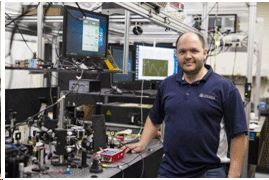|
NOVIDADES
A new technique to increase the speed of medical tests is combining cutting-edge nanoscience with a magnetic phenomenon discovered more than 170 years ago. The combination technique—created by Researchers at the University of Central Florida— could lead to a biochemical immunology test completed in as little as 15 minutes, compared to several hours for enzyme-linked immunosorbent assay, the current standard approach for biomolecule detection. If commercialized, the test could be utilized for HIV, Lyme disease, syphilis, rotavirus and other infectious diseases. Shawn Putnam, an assistant professor in the University of Central Florida's College of Engineering and Computer Science, said the new technique could be implemented everywhere.  Assistant Professor Shawn Putnam of UCF's College of Engineering & Computer Science. Credit: University of Central Florida
Putnam’s team coated tiny particles that are one-billionth of a meter to the antibody bovine serum albumin (BSA), which is commonly used as the basis of a variety of diagnostic tests. They mixed the nanoparticles in a test solution, which allowed the BSA proteins to preferentially bind with the antibodies that coat the nanoparticles. While the reaction was already known, Putnam’s team was able to produce a new way of measuring the quantity of proteins present. Putnam used nanoparticles with an iron core and applied a magnetic field to the solution, which caused the particles to align in a particular formation. The proteins binded to the antibody-coated particles, while the rotation of the particles became sluggish and easier to detect with laser optics. Putnam then adapted the Faraday rotation—the interaction of a magnetic field and light—for biological use. "It's an old theory but no one has actually applied this aspect of it," he said. Other antigens and their unique antibodies could be substituted for BSA protein used in the research, which could be used in medical tests for a wide array of infectious diseases. The study was published in Small. RDMag. Posted: Jan 23, 2017. |
|||||||||||||||||||||||||